These gluten-free multigrain bread rolls (aka German Brötchen) with a crusty outside and tender middle are filled with whole grains. They’re perfect for breakfast and dinner, plus the recipe is 100% vegan (egg-free, dairy-free) and yeast-free- no proofing required!
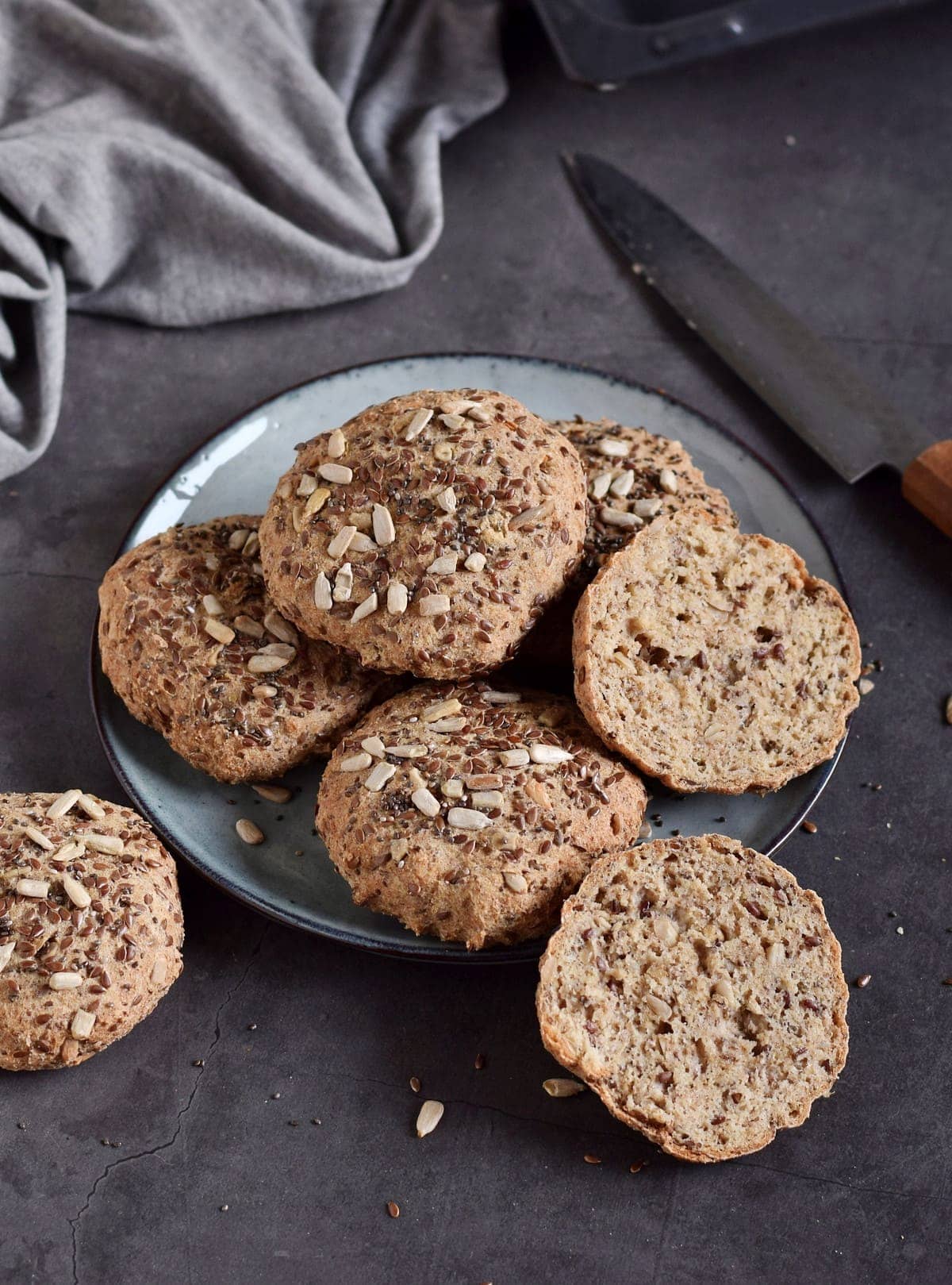
I’ve been in Germany for over two week now, visiting family and eating a lot of bread (we always do here, for breakfast and sometimes also for dinner!). I honestly think German bread is probably the best bread in the world! Am I biased? Perhaps, but try this German-style bread roll recipe (Brötchen in German) and tell me what you think!
I’ve previously shared recipes for gluten-free French bread (baguette) and flatbreads like pita and Indian naan. I’ve even once shared a gluten-free buns recipe for a fluffier type of roll. However, now it’s the turn of something sturdy and nutrient-rich while still gluten-free and vegan!
German whole-grain rolls practically aren’t even comparable to ones I’ve eaten in the US. The US bread is soft and sweet (and, honestly, probably not very healthy). In comparison, multigrain rolls are packed with whole grains and are tender without being too airy/fluffy, or sweet.
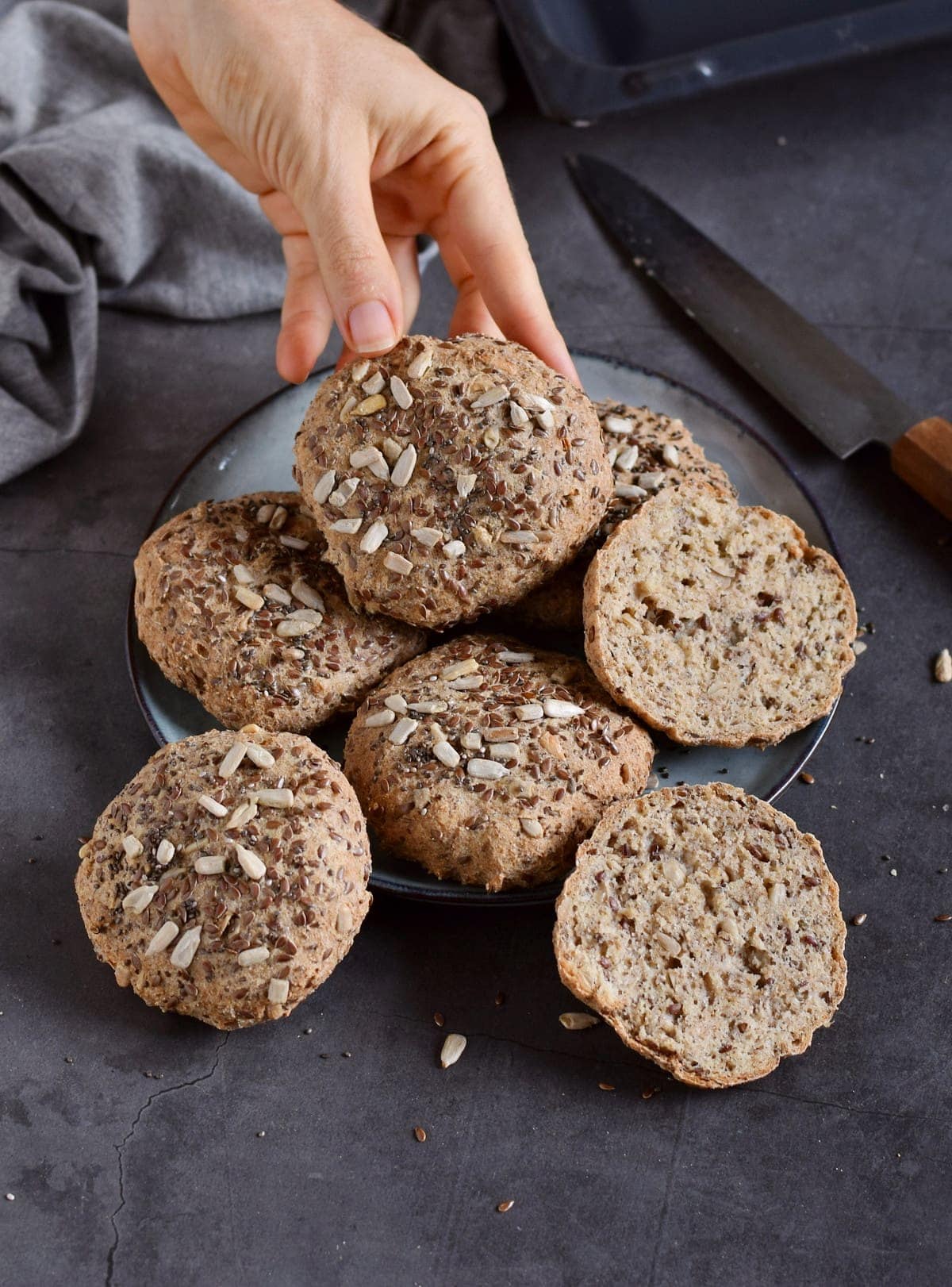
The Ingredients and Substitutions
- The seeds: I used a combination of whole flax seeds, sunflower seeds, and chia seeds soaked in a little hot water for these Brotchen. However, you can use any whole seeds of choice. Pumpkin seeds, poppy seeds, and sesame seeds, for example, work very well too. You could alternatively use a multigrain hot cereal mix (they often come in 5,7, or 10-grain options).
- The flours: I use a combination of brown rice flour, chickpea flour, and tapioca flour (or arrowroot flour) for the perfect texture and consistency. I’ve tried the recipe with oat flour (instead of chickpea) once, and it also worked, but I prefer chickpea.
- Psyllium husk powder: If you only have whole psyllium husk, you can grind it first in an electric coffee/spice grinder. This ingredient helps to mimic gluten where there is none and add ‘chew’ to the bread. It is vital to the bread roll recipe.
- Ground chia seeds: If you have whole chia seeds, you can grind them for a few seconds in a coffee/spice grinder or a blender/food processor.
- Baking powder: This leavening agent helps to provide lift to these no-yeast dinner rolls.
- Apple Cider Vinegar: I recommend using unfiltered and unpasteurized apple cider vinegar. ACV helps to strengthen gluten-free dough while also making a springier texture. Regular white vinegar will work if you don’t have ACV.
- Salt: For seasoning the gluten-free rolls.
- Water: Tap water is fine (if it’s drinkable where you live).
For the full ingredients list, measurements, complete recipe method, and nutritional information, please read the recipe card below.
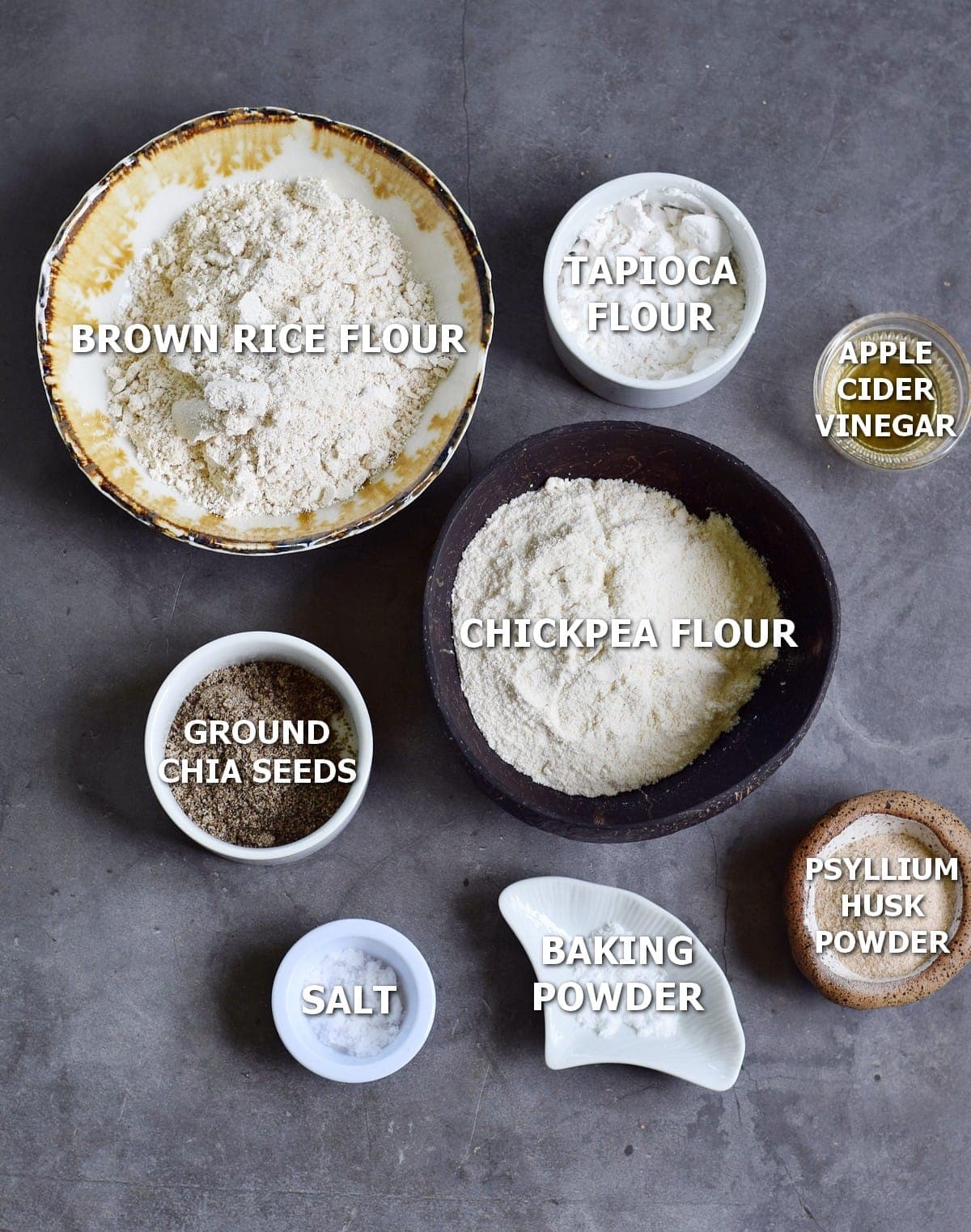
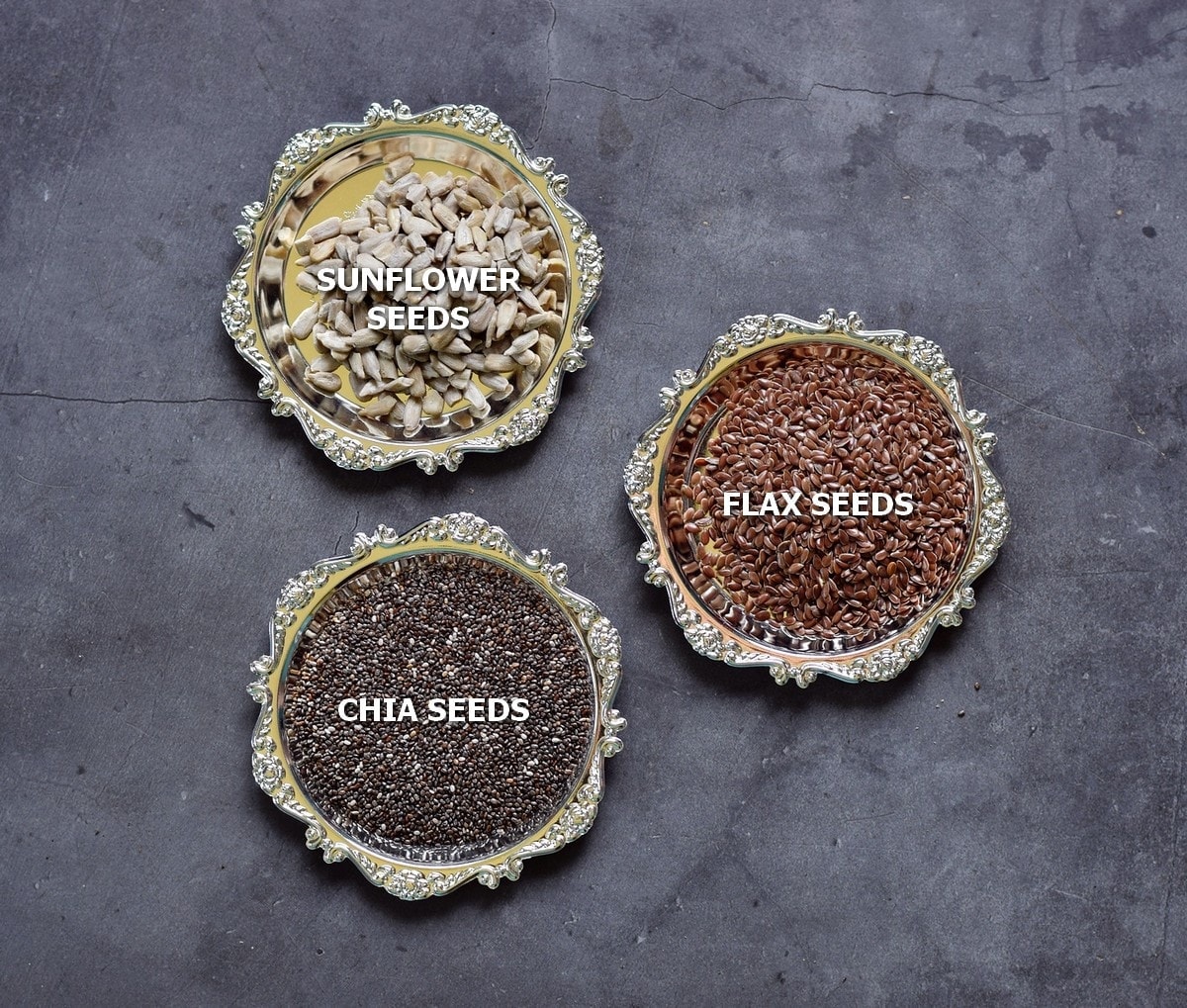
How to Make Gluten-Free Rolls?
- First, add the whole seeds to a small/medium bowl and pour the hot water over them. Mix with a spoon and let them rest for about 10 minutes.
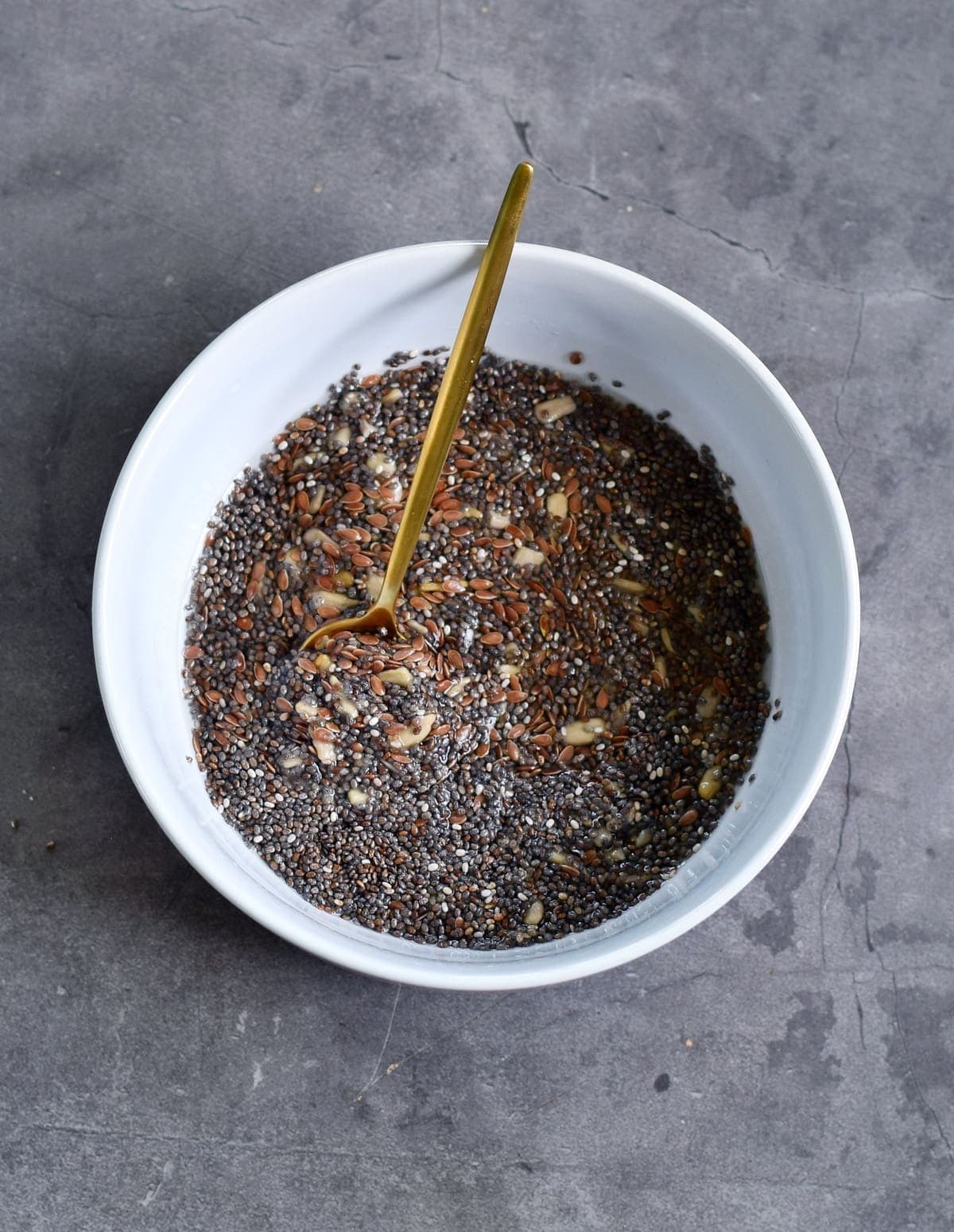
- Then, preheat the oven to 360F/180C and line a baking sheet with parchment paper or a silicone mat.
- Meanwhile, in a large mixing bowl, add the brown rice flour, chickpea flour, tapioca flour, psyllium husk powder, ground chia seeds, salt, and baking powder and mix.
- Then add the water, apple cider vinegar, and the wet seed mixture and stir with a spoon to create a shaggy dough.
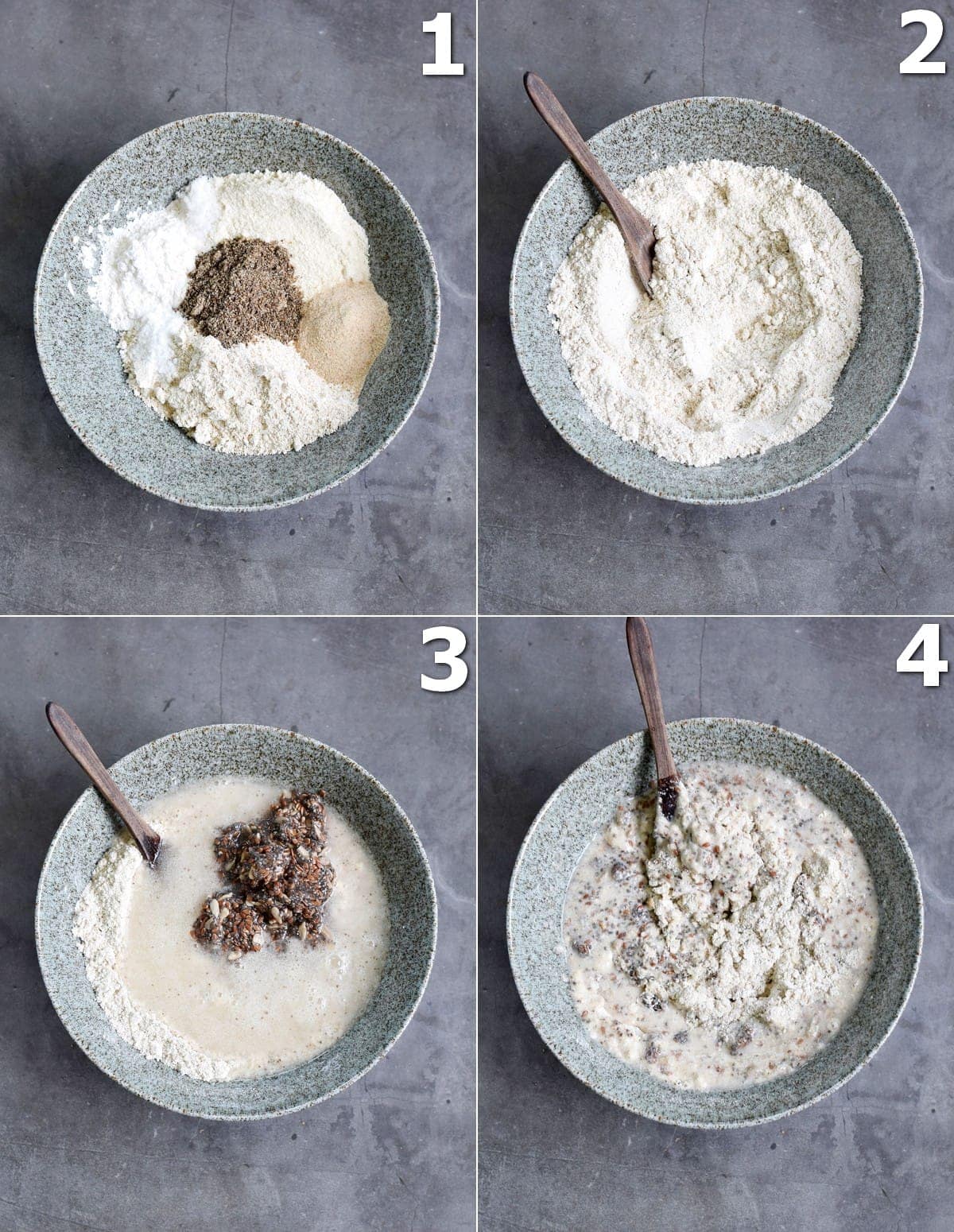
- Use your hands (or a mixer/processor with a dough blade) to knead the dough for a few minutes until smooth.
- When the dough is ready, divide it into six equal parts and shape each into a roll.
If you want complete accuracy, then you can weigh the dough and divide it by weight.
- Sprinkle the baking sheet with a thin layer of any seeds of your choice (unsoaked), then place the Brötchen over them, and finally sprinkle them with a few more seeds.
You can lightly brush the rolls with a bit of water to help the seeds adhere if needed.
- Bake the rolls in the oven for between 30-40 minutes until lightly browned and puffed up – then enjoy!
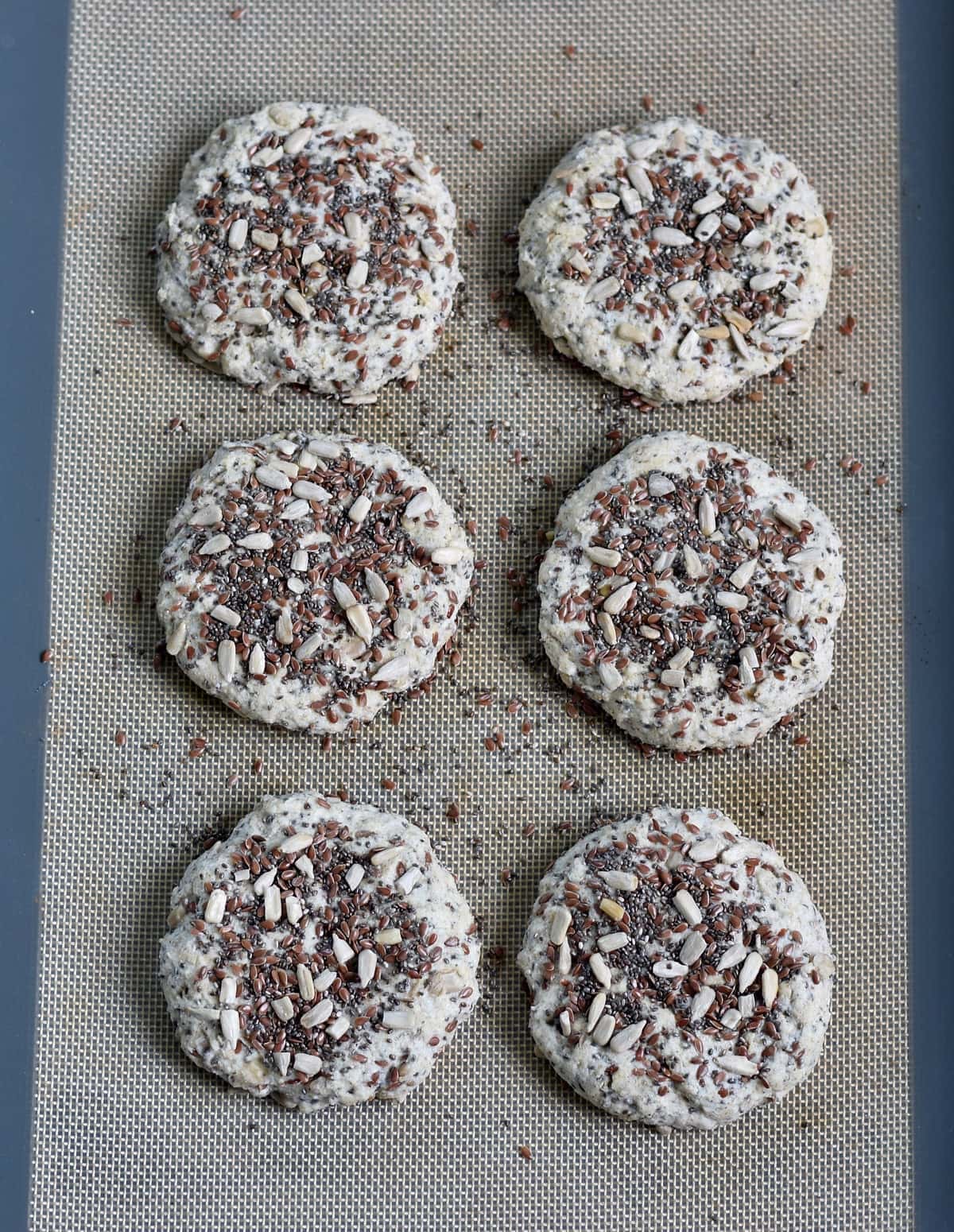
How to Serve and Store Brötchen?
Serve: There’s nothing better than the smell of freshly baked bread wafting through the kitchen. Even better, tear into one of these while warm and enjoy with a bit of vegan butter for a quick and delicious treat. Also, save them for sandwiches, soups (like this creamy carrot ginger soup or hearty corn chowder), stews, burgers, and for a German breakfast with dairy-free butter, jams, cheese, etc.!
To Store: Store the bread rolls in a bread bin or container for several days at room temperature. If they start to go a little hard, you can bring life back to them by warming them in the microwave or oven for a few minutes, sprinkled with a little water.
Freeze: Allow the rolls to cool entirely, then freeze for up to 3 months, tightly wrapped in plastic wrap.
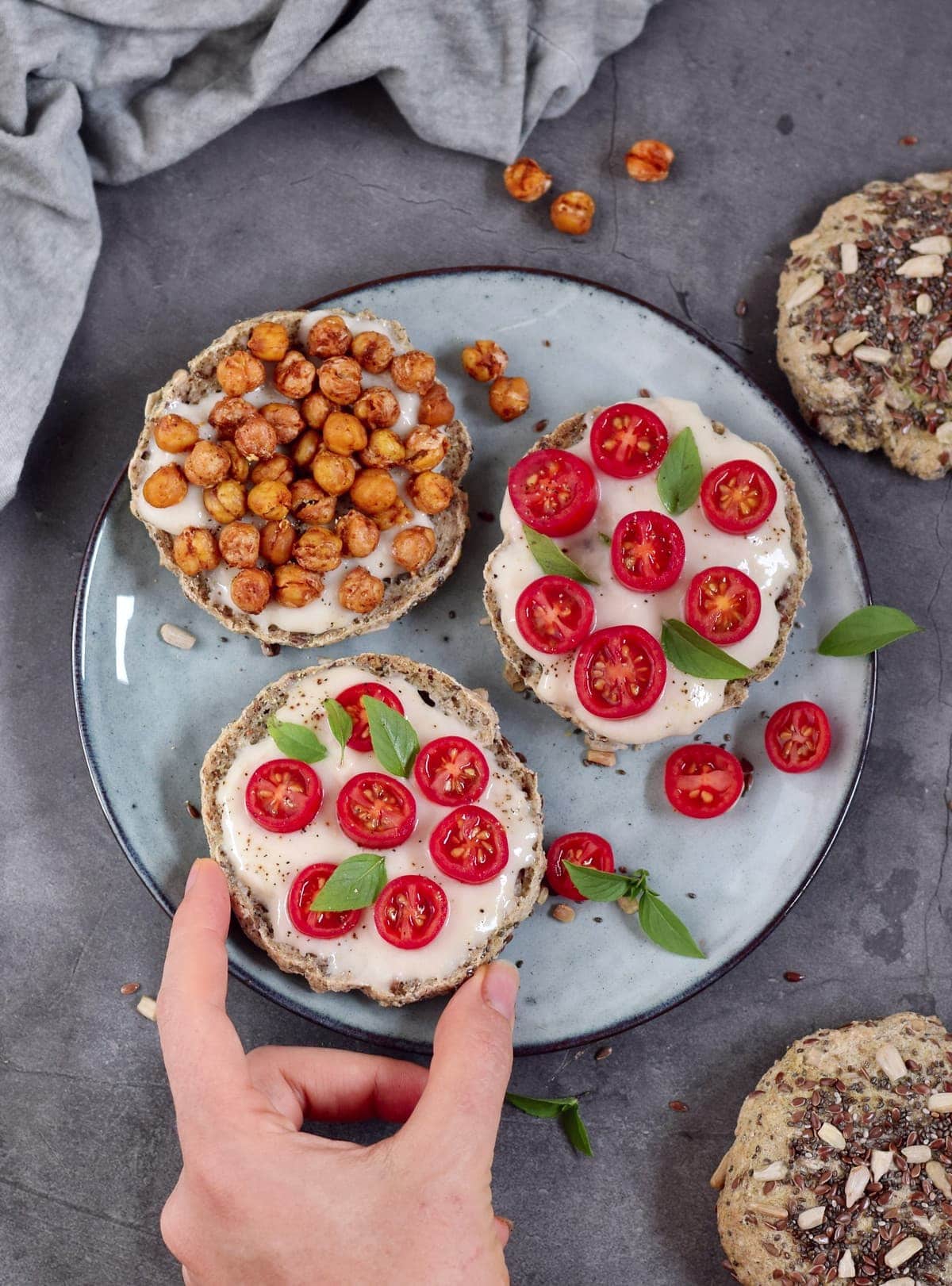
FAQs
Are multigrain rolls healthy?
Often multigrain bread is made from white flour with some added grains. Despite this, multigrain bread tends to have more fiber and a lower GI than white bread, resulting in longer-lasting energy.
Why soak seeds and grains before baking bread?
There are several reasons to soak seeds/grains. First, it helps to soften them and make them easier to eat. Soaking can also make them easier to digest. However, soaking also stops the ingredients from sucking up moisture from the bread dough.
Can I make the gluten-free rolls crustier?
You can add a few ice cubes (in an oven-safe dish) to the oven while baking the whole-grain rolls. This will steam up ad help form a crustier shell.
For a shiny, crackly crust, you could also create a cornstarch water slurry to brush over the rolls before baking.

More Recipe Notes
- Use a stand mixer/food processor: With a dough hook/blade to help mix and knead the gluten-free dinner rolls dough. As there’s no gluten in the recipe, you don’t have to worry about working it too much.
- If you prefer sweeter bread: I know I know; I said at the top how much I prefer bread without tons of sugar. However, if you do like a subtle sweetness, feel free to add a few spoonfuls of a liquid sweetener. Just note, this will make the dough slightly stickier, and you’ll need to reduce the water slightly so the dough isn’t too wet.
- Using oats to top: Instead of extra seeds, you could top the Brötchen with some oats instead.
- Use the leftovers for croutons: A slightly stale multigrain roll will work fine for making croutons. Dice them into even-ish pieces and then toss with seasoning and a little oil, then bake till crisp.
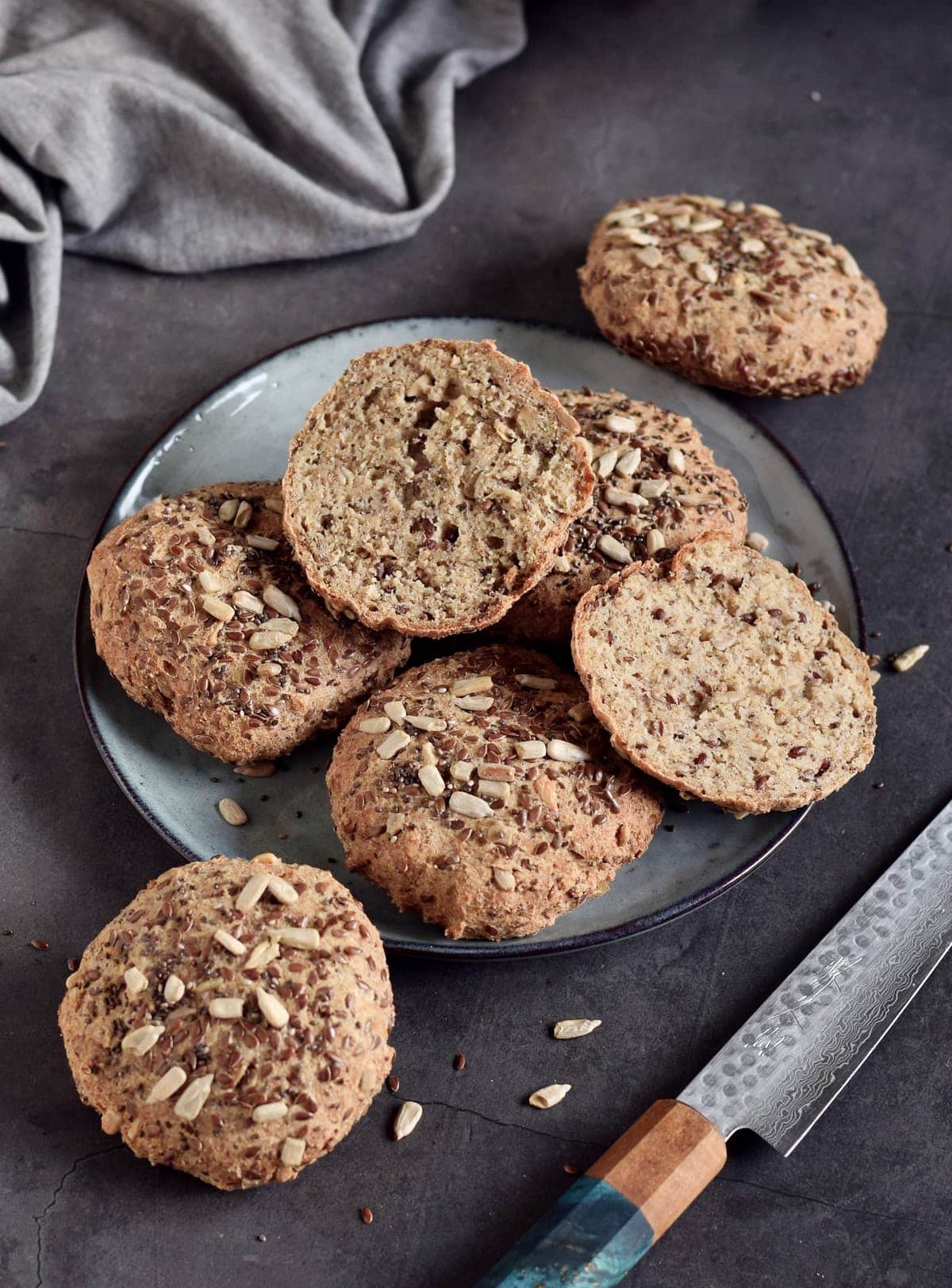
Other German Inspired Recipes
- German Potato Soup (Kartoffelsuppe)
- Creamy German Cucumber Salad (Gurkensalat)
- Potato Dumplings (Kartoffelklöße)
- Simple Sauerkraut from scratch
- German Potato Noodles (Schupfnudeln)
- Caramelized Onion Tart (Zwiebelkuchen)
If you try this recipe for German gluten-free rolls (Brotchen), I’d love a comment and ★★★★★ recipe rating below. Also, please don’t forget to tag me in re-creations on Instagram or Facebook with @elavegan and #elavegan – I love seeing them
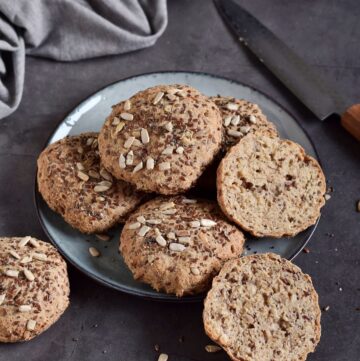
Multigrain Bread Rolls (Brötchen)
Ingredients
Seed mixture:
- 15 g (2 tbsp) whole flax seeds
- 15 g (2 tbsp) whole sunflower seeds
- 15 g (1 1/2 tbsp) whole chia seeds
- 60 g (1/4 cup) hot water
- More seeds to sprinkle
Flour mixture:
- 120 g (3/4 heaped cup) brown rice flour
- 70 g (5/8 cup) chickpea flour (see notes)
- 25 g (3 tbsp) tapioca flour (see notes)
- 15 g (1 1/2 tbsp) psyllium husk powder
- 15 g (3 tbsp) ground chia seeds
- 3/4 tsp salt
- 1 1/2 tsp baking powder
- 240 g (1 cup) water
- 15 g (1 tbsp) apple cider vinegar
Instructions
- You can watch the video in the post for visual instructions.Add the whole seeds to a small/medium bowl and pour hot water over them. Mix with a spoon and let it rest for about 10 minutes.
- Preheat the oven to 360 degrees Fahrenheit (180 degrees Celsius) and line a baking sheet with parchment paper or a silicone mat.
- Meanwhile, add the brown rice flour, chickpea flour, tapioca flour, psyllium husk powder, ground chia seeds, salt, and baking powder to a large mixing bowl.
- Add the water, apple cider vinegar, and the wet seed mixture and stir with a spoon. Then use your hands to knead the dough for a few minutes. You can also use a hand mixer.
- Divide the dough into 6 equal parts and shape each into a roll.
- Sprinkle the parchment paper (or silicone mat) with a thin layer of seeds of choice and place the 6 rolls on it. Sprinkle the tops with more seeds.
- Bake in the oven for 30-40 minutes and enjoy!
Notes
- Chickpea flour: I made the recipe with once with oat flour and it turned out good, but the result with chickpea flour was even better.
- Tapioca flour: You can use arrowroot flour instead.
- Seeds: Use any whole seeds of choice. Pumpkin seeds are amazing too!
Nutrition information is an estimate and has been calculated automatically
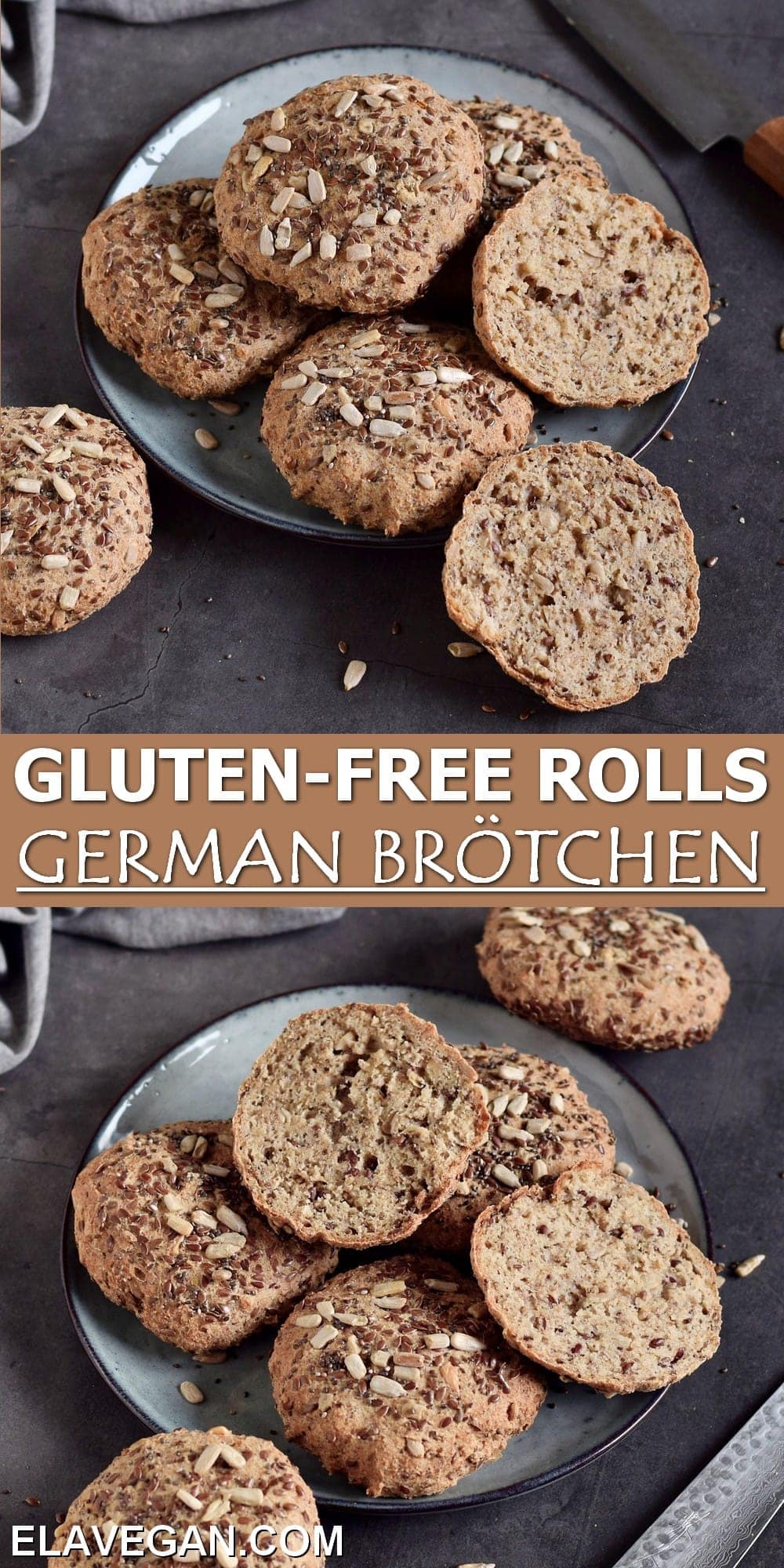

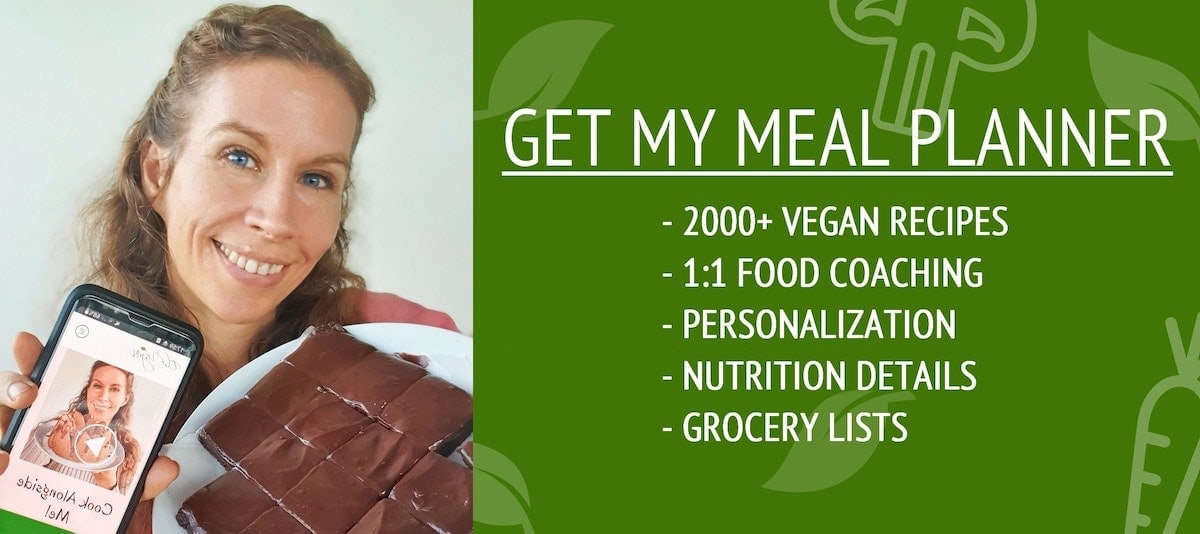
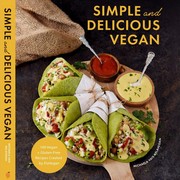
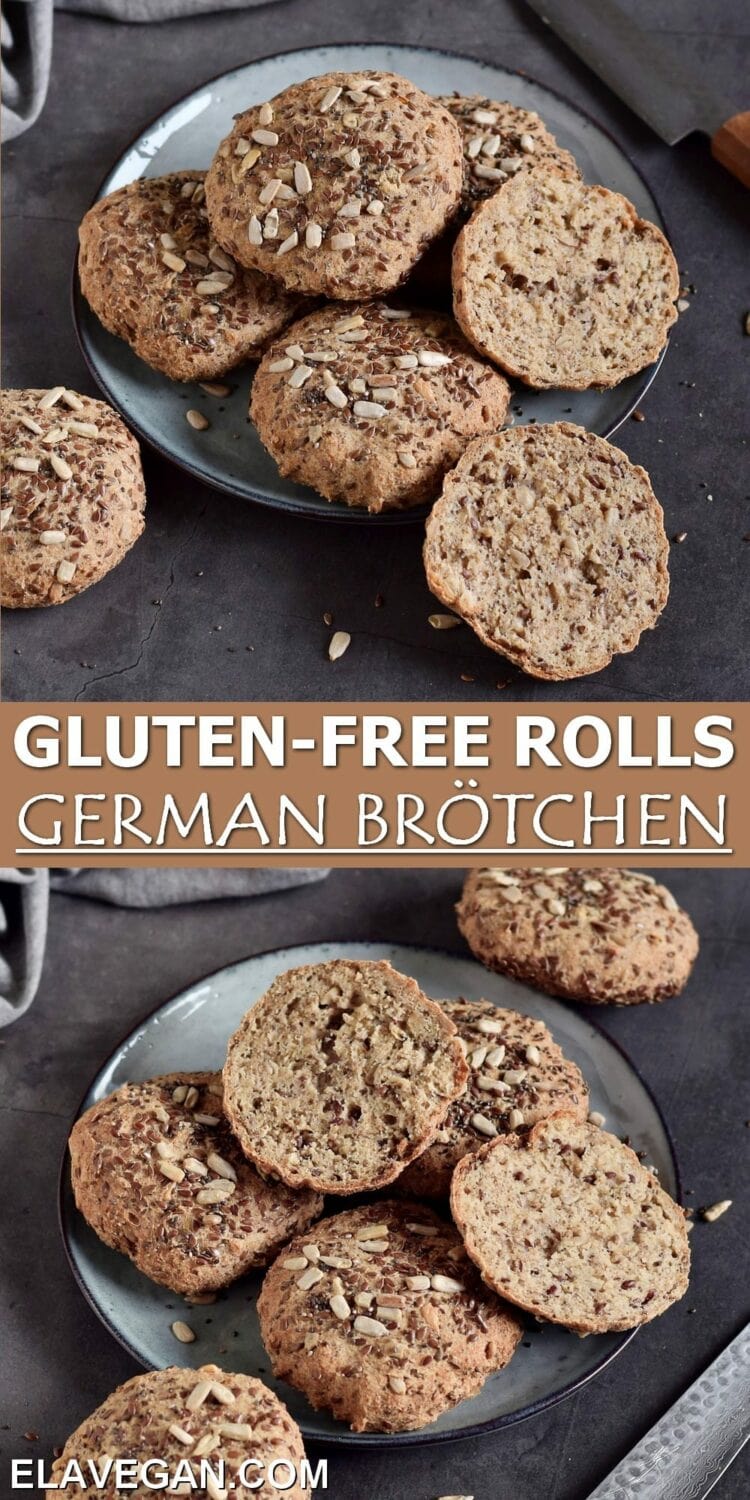
These came out pretty good, nice soft rolls and I enjoyed the flavor. They came out a little denser than it looks like in the photos- out of curiosity, when you designed the recipe, did you use the weights or the imperial measurements? I used the weights in grams, but I noticed it didn’t line up very well to the Tbsp or cup measures, so wondered if that was why.
Hi Cecelia, I always create my recipes with metric measurements. 🙂
I am extremely impressed by this recipe. It’s really spectacular. I didn’t actually get to knead my dough because it was pretty sticky. I let it sit a bit longer after I mixed it and it became less sticky but still not enough that I thought I could knead it so I just scooped it up into a ball and sectioned it out into four (instead of 6). I baked about 28 minutes and they came out perfect. Recipes with chickpea flour in them usually scare me but these buns are very tasty and have a great texture.
You are very welcome, Amanda. Thanks for your feedback. 🙂
I made these rolls yesterday. The taste was really good but they were so hard. What would the reason be?
Thanks.
I am really not sure, because they always turn out very soft due to all the seeds and psyllium husk powder. Did you change the recipe slightly?
It’s the BEST gluten-free multigrain bread I’ve ever had/made. It’s my second time baking it as sandwich bread. Thank you for the recipe. It tastes as good or far better than the brötchen I had in Deutchland. This certainly will be my GO TO recipe for gluten-free bread.
Vielen Dank! Liebe Grüsse.
Sounds amazing! Glad you liked them, Phuong. 🙂
Ella
I very happy I finally got around to making these today. I was worried that the seeds would take over the flavor of the bread but they did not. I will make the rolls again, but I would like to try the ice/ stream method for a crusty outside. Thank you for your hard work and sharing.
Aww, so glad you like them! 🙂